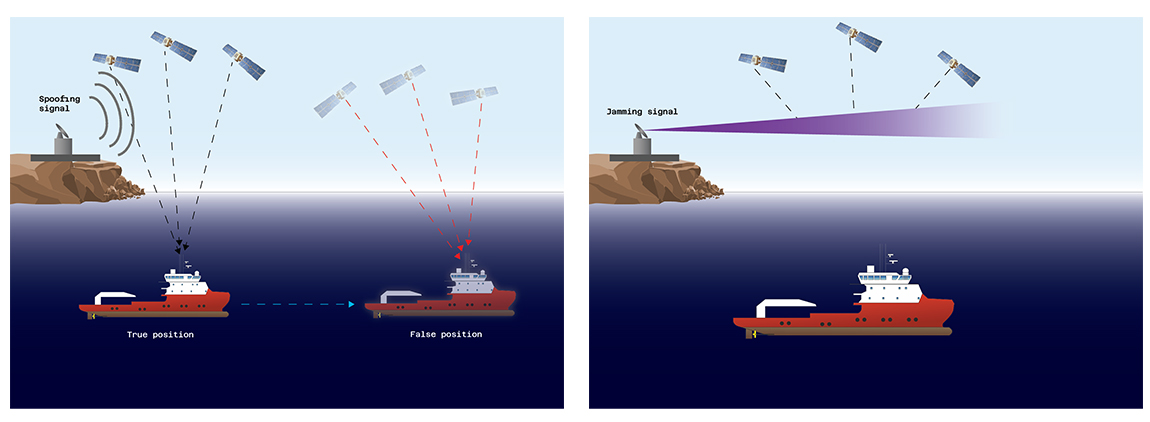Understanding the differences between jamming and spoofing is essential when dealing with security and interference in maritime communication and navigation systems. Both are forms of interference, but they work in fundamentally separate ways with distinct threats.
What is jamming?
Jamming is the intentional disruption of signals by overwhelming a communication frequency with noise or other signals. This prevents devices, like navigation systems, from properly receiving and transmitting data. It can disrupt satellite signals, affecting a ship’s ability to determine its position, speed or course.
It can also prevent a vessel’s position from being transmitted during an emergency distress call over marine VHF radio and can interfere with radar systems used for navigation, collision avoidance and weather monitoring.
Jamming is considered a brute force attack targeting availability, aiming to deny service rather than manipulate data.
What is spoofing?
Spoofing is when someone tricks a system by sending fake signals. This makes the system show the wrong location or act incorrectly. For example, in GNSS spoofing, false signals can fool navigation systems into thinking they are somewhere they are not. This can cause navigation errors or confusion. Spoofing can also disrupt the timing system on a vessel, now heavily relied on in many marine systems.
Unlike jamming, spoofing needs advanced skills and knowledge of the system being targeted.
Key differences

| Aspect | Spoofing | Jamming |
| Method: | Generates fake signals to deceive | Overwhelms signals with noise |
| Objective: | Misleads or manipulates systems | Denies service or communication |
| Complexity: | Requires specialist knowledge | Simpler, brute force approach |
| Target: | Data integrity and trust | Communication availability |
A real-world challenge
Over the past year, ships have been significantly impacted by AIS and GNSS spoofing incidents in multiple regions.
In the Baltic Sea, vessels have falsely reported positions to obscure port visits, while in the Sea of Japan, tankers involved in Russian oil transport have shown manipulated tracks and false AIS data.
In the Red Sea and Strait of Hormuz, widespread GNSS interference has caused erratic vessel movements and positional jumps.
One of the most striking incidents occurred near Crimea, where dozens of ships appeared to transmit AIS positions placing them inland at airports.
These spoofing events have led to major discrepancies between actual and reported vessel locations, sometimes displacing ships by tens or even hundreds of kilometers.
Defending against jamming and spoofing: The role of SPRINT-DP
When it comes to critical offshore operations such as surveys, pipe laying and construction, reliable positioning is essential. SPRINT-Nav DP is your defence against both jamming and spoofing threats.
By integrating advanced inertial navigation with multiple sensor inputs, SPRINT-Nav DP provides accurate, resilient positioning even if GNSS signals are compromised. Its ability to detect and reject falsified signals, maintain situational awareness during signal loss and seamlessly switch between navigation modes ensures continuous and trustworthy operations.
For operators in tough environments, SPRINT-Nav DP is your go-to for keeping things steady—protecting your assets, crews and missions from the constant challenges of jamming and spoofing.